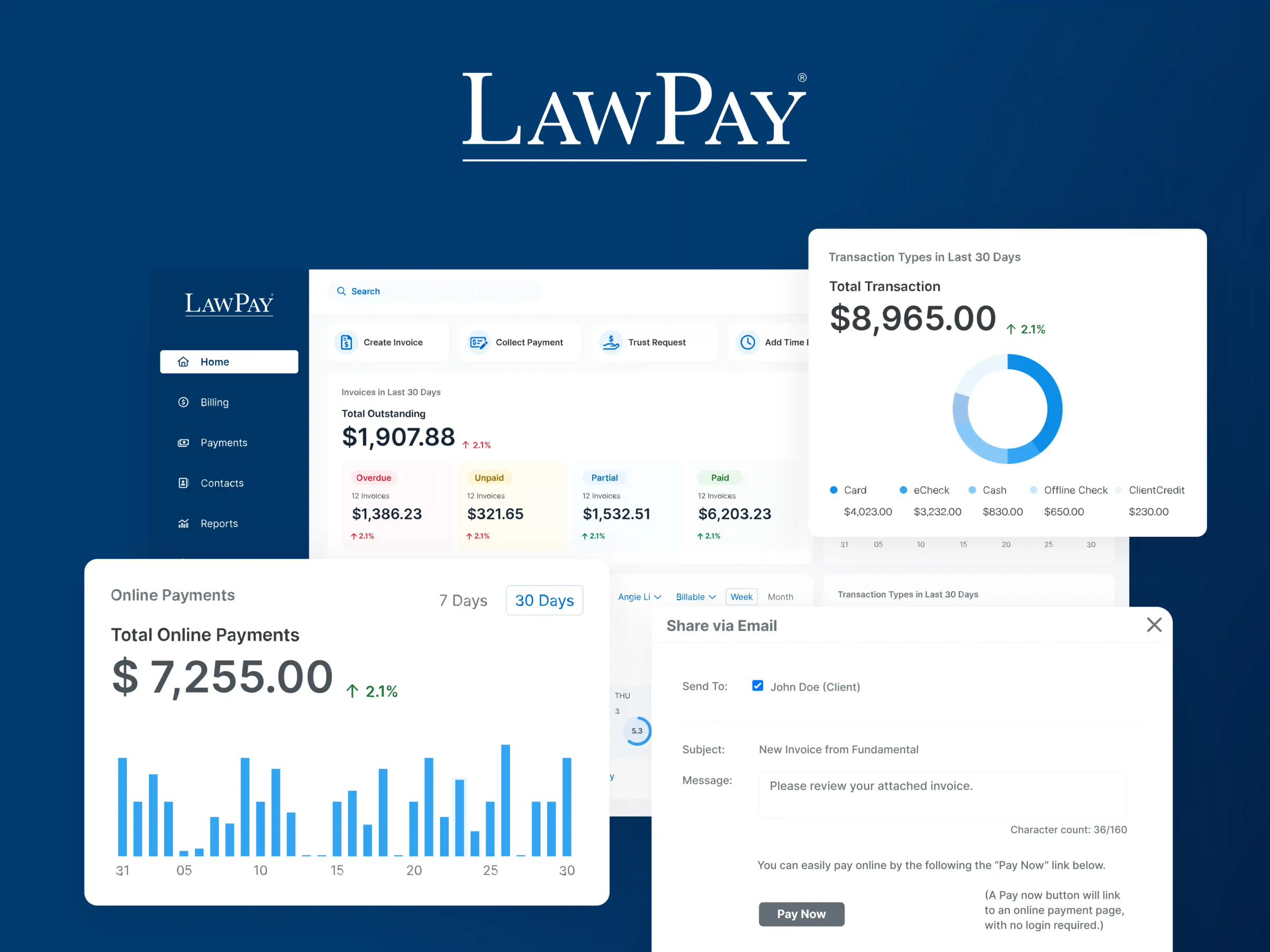What is an Alternative Fee Arrangement?
While it’s still most common for law firms to charge on an hourly basis where billing is concerned, this is no longer the only available option. Alternative fee arrangements are any agreement between your firm and your clients about how they’ll pay for legal services which don’t rely on hourly billing.
With today’s clients expecting more convenience and flexibility, you might want to explore alternative fee arrangements for law firms.
What are the Advantages of Alternative Fee Arrangements for Law Firms?
Innovative legal companies pioneered alternative billing arrangements for lawyers because they have many unique advantages over hourly billing. In the next few sections, we’ll discuss these advantages so you can decide whether you want to incorporate an alternative fee arrangement in your law firm.
Schedule a demo to see what LawPay can offer your firm.
Book Now
Better Billing and Collection Workflows
An important part of running a successful legal practice is actually getting paid. This involves sending and processing invoices, following up with clients, and collecting your fees.
Simplifying and streamlining this work is one place where alternative fee arrangements for law firms can be a huge competitive advantage.
For an easy example, consider a flat fee, which we’ll discuss more below. Charging a single, standard rate for legal services means that billing for those services is as simple as it possibly can be–the number is always the same, and doesn’t change based on factors like the number of hours worked.
When paired with industry-leading e-billing software for law firms, such as LawPay, these advantages only get bigger. LawPay makes it easy to handle the financial side of running a law firm by offering attorney fee agreement templates and helping with drafting a fee agreement, among other things.
This functionality makes capitalizing on alternative fee agreements even easier.
Client Trust and Satisfaction
Customer satisfaction is as important in the legal profession as in any other. People in need of legal assistance are generally facing some sort of large-scale challenge in their life, such as a divorce, injury, or another legal battle. Earning their trust and helping them feel seen and understood will go a long way toward establishing your reputation and ensuring your future success.
Providing alternative fee arrangements for these clients can be one way of accomplishing this goal and help to set your firm apart from the competition. And there’s a clear market demand for such options. In 2021, Bloomberg Law conducted a survey that found that a remarkable 85% of law firms using alternative fee arrangements did so because that’s what their clients wanted.
By offering a variety of different ways to pay for your services, you’ll be able to serve a broader customer base by meeting potential clients where they’re at financially.
Price Transparency
Transparency in your law firm’s pricing is another place where you can satisfy clients. Of course, from your perspective hourly billing may seem really straightforward. After all, it’s just your hourly rate times the number of hours you actually worked, which isn’t difficult math to work out.
But from the client's perspective, things could be less clear. Outside the legal profession, people are unlikely to know what a lawyer actually does within an hour, and why something that sounds straightforward (i.e. filing some paperwork) might actually be pretty involved.
However, if you’re charging a client a flat rate, a subscription fee, or a success fee, some of the confusion that comes along with an hourly rate is cleared up. In these instances, there’s a single dollar amount (or percentage) that’s explained to the client upfront, and they can decide in advance whether and how to pay.
A potential client already has a lot going on, they’re not going to want to keep track of your hours on top of everything else. If you’re the only law firm they speak to that offers an alternative path forward, they’ll likely remember that.
7 Top Alternative Fee Arrangements
With the rising popularity of alternative billing arrangements for lawyers, many variants have emerged. Each comes with pros and cons, and we’ll walk through these considerations below so you have all the information you need to make the best decision for your firm.
Subscription Fees
Subscription-based models have increased in popularity with a number of products, and they’ve begun catching on with law firms as well.
A subscription fee works the same way in a legal setting as it does with a streaming service or an athletic club—you get access to something in exchange for a set recurring amount, usually paid monthly.
The biggest advantage of this alternative fee arrangement is that it makes your services more affordable. There are likely many businesses that would elect to pay you subscription fees in exchange for periodic legal counsel that don’t have the budget for a big advance retainer payment. This setup has the additional benefit of giving your firm more consistent, ongoing revenue, as well as offering a way for you to develop lasting relationships with clients.
The tricky part is figuring out how to structure the subscription service. If you don’t account for the specifics of your situation and client base, you could end up over or under-charging.
2. Payment Plans
According to the MyCase 2021 Legal Industry Report, 73% of 2,000 surveyed legal professionals stated that getting paid was a challenge for their firms. Perhaps this is why more and more law firms are opting to offer payment plans. A payment plan is similar to a subscription in that the client will make ongoing monthly payments. The difference is that a payment plan ends whenever the full balance has been paid, whereas a subscription continues until the client opts out.
Payment plans provide clear advantages and flexibility to clients. What’s more, you can simultaneously meet an increasingly-common desire on the part of potential clients to have access to payment plan options. The downside is that it will take longer to get the full amount you’re owed.
3. Fixed or Flat Fees
Also known as ‘fixed fees’, flat fees are a law firm alternative fee arrangement that has the client agree to a single, predetermined fee at the outset. Rather than charging hourly to draft a will or contest a traffic ticket, for example, you’d simply quote a reasonable figure to handle that particular task from start to finish.
The biggest advantage of this approach is pricing transparency. The client won’t be confused or surprised by a bill that’s larger than expected, which will help foster trust and a positive client experience.
But you have to think carefully about your flat rates. If some task ends up taking five times longer than expected, you could end up receiving a much smaller payout than you would have if you had opted for the standard approach of billing hourly.
4. Contingency Fees
With a contingency fee arrangement, your compensation comes in the form of a percentage of a client’s payout assuming their case is successful.
This is a popular choice in situations where the case is large and complex and the client may not be able to afford a big legal fee. If a person is suing a hospital for botching a difficult surgery, for example, a contingency fee would work well.
The advantage to a contingency fee is that your payout could be substantial if you’re victorious in court. It also puts your services within reach of people who may not be able to afford them otherwise.
Of course, if you lose then you’ll receive no payment for your work. And contingency fees can be fraught with ethical problems. There are certain types of cases where they’re not allowed, and you have to check your state’s regulations around them before making them available to potential clients.
5. Success Fees
Closely related to the contingency fee is the success fee. With a success fee, you’re generally offered a certain, predetermined amount of compensation regardless of the outcome of the case. However, if you win you’re entitled to additional compensation.
6. Capped Fees
A capped-fee arrangement borrows elements of hourly billing and flat fees. In this instance, you may charge your customary hourly rate while agreeing in advance that your total bill will not exceed a predetermined amount. If you’re used to hourly billing then you can continue using it, while your client can rest easy knowing that their legal fees will never exceed the cap you’ve agreed to.
7. Sliding Scale Fees
Sliding scale arrangements are ones in which you tailor your rates to the specific details of a client’s particular circumstances. For example, you might charge $200 an hour for a client that makes well over six figures and $85 an hour for a client of more modest means.
The main advantage of this approach is that it will allow you to serve clients who might desperately need legal help but may not be able to afford your services otherwise.
Schedule a demo to see what LawPay can offer your firm.
Book Now
How Legal Billing Software Can Help With Managing Fee Arrangements
With the rise of digital services and a panoply of different payment mechanisms, billing practices for lawyers are changing. On the whole, this is allowing them to serve more clients while also offering a better overall client experience. LawPay’s billing and payment solution is purpose-built to offer greater flexibility in how lawyers structure their fee arrangements, freeing you up to think about how best to run your legal practice. Schedule a live LawPay demo today.
About the author

Trent Fowler
